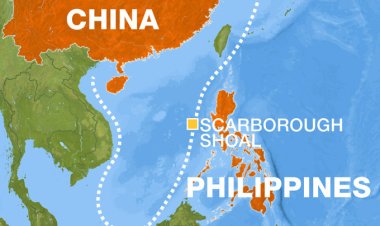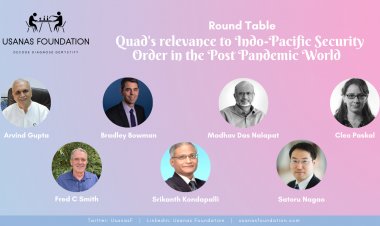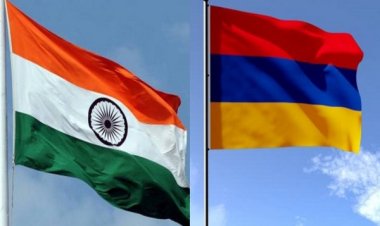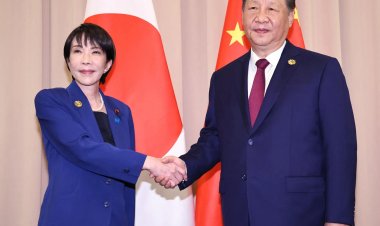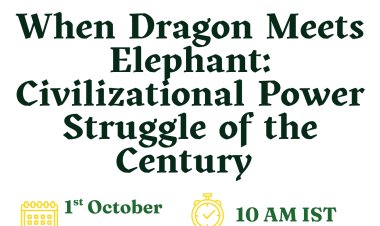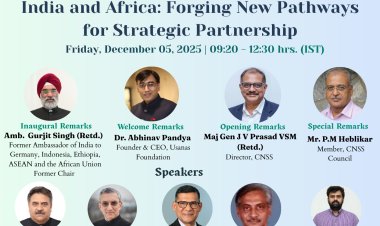Russia-China World Order: India's Choice
What we are witnessing in Ukraine now, in 2022, is the biggest real roll-back in over 100 years of the US striving for the status of "world power."
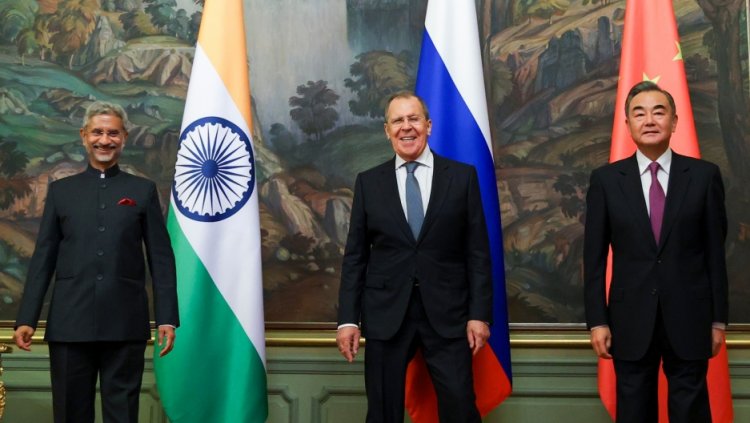
Opinion Brief
By Karsten Riise
A Momentous Change
What we are witnessing in Ukraine now, in 2022, is the biggest real roll-back in over 100 years of the US striving for the status of "world power." The US ambition to dominate the world began in 1918 when the Americans regretted that they did not use their overwhelming position after winning in World War I to replace the failing British Empire. 2022 may put the tombstone on Western domination in all its forms over the past 500 years.
Let us start this discussion by looking at some very urgent developments inflicting enormous costs on the West. The Dow Jones Index of US stock values is already (per 9 March 2022) around 10% down since the beginning of 2022 when the Ukraine tensions started to grow. Stocks will only fall further. Energy and food prices will rise as well. Even before sanctions caused price surges in energy and food, Western inflation was already running out of control with 7.9% inflation in the US and 5.5% inflation in the EU. Moreover, Western government debts are unsustainable. US debt is 130% of GDP. Italian debt is 142% of GDP (2021). An Italian debt crash threatens the Euro. German debt is also starting to surge with € 100 billion extra public spending for the military – which only fills the coffers of F-35 supplier Lockheed-Martin in the USA. Near-zero Western interest rates are unsustainable, with around 2% interest rate and 7.5% US inflation. The US trade deficit is unsustainable, as it exceeds 7% of GDP. As the USA goes the road of the Weimar Republic, how much longer will the world accept massively printed US dollars as "money"? When international investors lose faith in US "values," the US real estate prices, stocks, bonds, banks, and the dollar will crash, and US interest rates will sky-rocket. Capital flight will set in, and there will be social upheavals like never before.
Chinese and Asian imports, including ever-cheaper clothes, have been reducing the total consumer costs for poor and middle-class Americans for years. If the US bans Chinese and Asian imports, inflation and the cost of living for Americans will increase even faster. Subsequently, US living standards, production costs, and employment will crash. When China takes Taiwan (not if), an immense threat to the supply of microchips to the USA will endanger the future of the entire US economy. The US financial bubble driven by gigantic dollar-printing is about to bust. The US has already lost military credibility with Iraq, Afghanistan, and now, Ukraine. US sanctions might turn out to be "boomerang sanctions," hitting the West harder than resilient Russia and China. There will be a loss of respect for the USA.
Let me next proceed by zooming in on a key aspect just to get more texture on the above forecast. As a background, Russia supplies 41% of the EU's gas and 55% of Germany's requirements. Russia also supplies 27% of the EU's oil and 47% of the EU's coal. No matter what they do, the EU cannot live without Russian gas for the next decade. Moreover, Russia supplies over 12% of the world's oil. 10% of Russia's export earnings come from wheat. Together Russia and Ukraine are dominant players in the global wheat business.
The price of Brent oil has touched 130 dollars as of 9 March 2022. Gas prices have soared by more than 70%. Where will oil prices stop? At 150 dollars? Or 200 dollars? The sky is the limit. However, the development of infrastructural and financial structures for oil/gas trading between China and Russia has been extremely extensive in recent years. Therefore, China and Russia will continue to go about their oil and gas trade – and all other trades – relatively unhindered.
Therefore, the energy crisis will not hit China. With Russia, China's oil and gas prices are not fixed in London or New York, deliveries are not paid in dollars, and payments are not transferred through SWIFT. The Western economies may crash, but China will be exempted from such a crash. China enjoys big exports to the USA but does not rely on them. China has made itself independent of exports to the USA and the West. China has done so by creating its own separate economic eco-system with China's internal economy together with Russia, ASEAN, South Korea, Taiwan, Pakistan, Central Asia, Iran, South America, and Africa. During the Trump presidency, China stopped considering booming exports to the USA as a necessity. When the US economy crashes, China will just feel a bump. India would like to be exempted from a Western crash as well. Its rival, Pakistan, has prepared against Western calamities by trading with China and recently securing energy from Russia. The West can do nothing. The US and NATO have no military means against Russia or China. Western sanctions only self-harm the West without hurting Russia and China. See my recent piece "Sanctions – What sanctions?" from 4 March 2022. Also, see my analytic overview in "USA is Checkmate" from 10 June 2021.
China and Russia have planned the Ukraine war and its fallouts together. This obviously includes the timing of its beginning 24 February 2022, right after the end of the Beijing Winter Olympics. China only needs to deny this in order not to provoke further irritation from the USA. After the coming war on Taiwan, China will be militarily suzerain in East Asia and in control of the world's supply of microchips. Taiwan, ASEAN, and South Korea are already fully in China's economic zone of influence. Their successful economies with China, not US abuse of words like "democracy," is what matters most to all of them. ASEAN is also already in China's military zone of influence. By taking Taiwan, all East Asia, even South Korea, will firmly come under Chinese military protection. With Taiwan going to Beijing and China's PLA Navy dominating the seas beyond the 1st Island Chain, the USA will have lost any logistic foundation for maintaining its 28,500 soldiers stationed in South Korea. Japan and Australia may try to hold out but cannot do so forever. Both Japan and Australia rely heavily on trade with China. Australia depends on exporting iron ore to China's military industry. China is already moving in on the Solomon Islands and all the other Pacific Islands, dominating the USA and Australia logistics. After yet another US setback, next time with Taiwan, the islands of Japan will militarily become so isolated and weakened by China's PLA Navy and Airforce that symbolic Japanese military manifestations will make little sense.
Latin America will also come firmly into China's sphere. US power in Latin America under the "Monroe Doctrine" was primarily maintained with economics, politics, and covert US operations to exploit South America and install dictators like General Pinochet (Chile), General Videla (Argentina), Somoza (Nicaragua) to control Latin America as de-facto colonies. China has now firmly achieved the position as leading trading power with all vital South American economies like Brazil, Argentina, Chile, Peru, and Venezuela.
Africa deeply appreciates that China is competing to give better prices for African exports. Africa also benefits from the fact that China's enormous investments in infrastructure are often more price-value competitive than similar offers from the West. Even Egypt is betting big on investments and infrastructure from China, including Chinese entrepreneurs greatly involved in the erection of Egypt's new administrative capital. Egypt also cooperates with Russia in military, arms, and logistics near the Suez Canal for civilian and military purposes. The EU, France and Britain are holding out with their neo-colonialism in Africa with their "stability" interventions, trade policies undermining Africa's food sector, "aid" to keep Africa poor, and NGOs manipulating African populations and governments on behalf of Western leaders. The West essentially wants to convince Africa that poverty is heaven and non-growth is happiness. When China has retaken Taiwan, the EU and USA will be in total disarray, and Africans are so unhappy with them that the West will lose its control of Africa.
Europe, including the UK, will decline because they are so deeply connected with fundamental US military and economic fragilities. The EU can shout loud, waste billions on American weapons, and join futile US sanctions, but they are all powerless against Russia. Economically, the EU cannot manage without dealing with China and buying microchips from Chinese Taiwan. France is positioning itself the post-Ukraine future. Even after Ukraine and a Taiwan-war, EU-China trade will continue, also over land via Russia and Ukraine.
As the West self-destructs, will India fall into the Western trap and share the Western route down? Or will India reinforce its traditional independence and share the enormous opportunities of the future? To shape a mutually beneficial future, China and Russia have a big interest in making peace between India, Pakistan, and China. India shares that interest too.
After Ukraine and Taiwan
What happens when Russia has won the war in Ukraine? Because, in my opinion, Russia will win that war. Every US media outlet talks about Russia being "stalled" in Ukraine; this is likely to be propaganda. Zelensky in Ukraine is becoming ever more desperate. It is unfortunate for Zelensky that he believed that US sanctions and small weapons could deter Russia. Ukraine is systematically losing, and there will be no "guerilla" war in Ukraine. If Russia wins and China goes on to retake Taiwan, what will the world order look like?
Firstly, Georgia and Moldova will become part of the Russian area. The US and NATO "security guarantees" will soon be null and void for the Baltic countries and Finland. In East Asia, as outlined above, not only Taiwan but ASEAN and even South Korea will be part of a Chinese area of economic and military suzerainty. East Asian growth and prosperity will continue, but the US will have no power there. Therefore, the alliance between Russia and China will boom. But what will be the material foundations for Russia and China in that World? And what are India's opportunities in this? Let us have a look.
World order's Material Foundations
Russia delivers 14% of the world's mineral extraction. Russian resources include oil, gas, nickel, aluminum, titanium for aircraft, palladium, diamonds, gold, iron, uranium fuel, coal, and wheat. Moreover, the strategic electrification of post-fossil fuel societies and the production of aerospace and other high-tech products depends on 17 rare earth metals. China, along with Myanmar, controls 72% of the global supply of these metals. China supplies 70% of the world's batteries. For the construction of a high-tech planet, we can also look at the geographic distribution of the necessary STEM graduates (science, technology, engineering, mathematics). China in 2016 could count 4.7 million STEM graduates – more than the rest of the world combined. Russia alone counts 0.6 million STEM graduates, equal to the "mighty" USA. Iran, a friend of both Russia and China, counts over 0.34 million STEM graduates, 70% more than Japan's 0.2 million STEM graduates.
Or we could count the share of microchip production at various nanoscales, where one factory, TSMC in Taiwan, has by far the dominant position in the World. We can also look at one of the other leading microchip manufacturers, South Korea. South Korea already exports far more to China than to the USA, and for that reason, South Korea has already rejected US pressure to join the anti-China Quad alliance. Assuming China invades Taiwan, South Korea will move fully towards China, and the US global position in technology will be lost to China. China has by far the biggest markets in leading industries like cars and smartphones, which drive global innovation in Artificial Intelligence, electrification, and microchips. Hence innovation in these leading tech industries is centered on and dependent upon China. If China is sanctioned, it will immediately do as Russia has just done: stop paying software licenses, and break the source codes for all Western software to reengineer their own versions. For details and sources on the complexities of much of this and more, please refer to my research "China-US Balance" from 23 February 2021. The conclusion is that the Russian military and energy, along with China (assuming it invades Taiwan), will have the upper hand against the USA.
Methodology - Measuring Material Foundations
Let us here go a little further and look at how to measure the overall global structure of material consumption and production. As an economist, I will assert that this is my science. While finance is immensely important, we must look at finance as a separate circuit from the real-world flow of production and services. To be more precise: The measure of Gross Domestic Product (GDP) does not always provide the correct image of the relative levels of material capacities and power in consumption and production when comparing countries internationally. This also applies when comparing the material power to buy and produce military arms and forces. Public salaries paid to go directly into a country's GDP measure at face value without adjustments. A Chinese Colonel may earn $37,000 and a US colonel may earn $88,000 (2.4 times more). But that does not mean that a US Colonel is better than a Chinese (or Russian) Colonel. A Chinese Brigadier General may earn $ 42,000 and a US Brigadier General may earn $ 116,00 (2.7 times more). But that does not mean that a US Brigadier General is better than a Chinese or Russian Brigadier General. The same, of course, holds when comparing Indian, Pakistani, or Iranian militaries with the US. Many US Generals are only administrative paper-pushers, triple-checking boxes on schemas, or lobbying for US arms producers. This reasoning, of course, also stretches to other public services and private services like engineering infrastructure and weapons. An additional disturbing factor for comparison is, of course, when the US has far too many officers. Their oversized costs increase US GDP but detract from US effectiveness.
The key issue is exchange rates, payment, and price levels. If the biggest US banks on Wall Street feel nervous, the currency of a particular country may drop 30% overnight, as has just happened to Russia with the Ruble. This would technically reduce Russia's total GDP and GDP per capita by 30%. However, this is only a technicality, for the Russian standard of living may go on basically at the same level. Let us take an example. If Joe in the USA earns 20,000 dollars a year, and Vladimir in Russia only earns 5,000 dollars a year, Vladimir's earnings are technically only a quarter of Joe's. But if an American hamburger costs 10 dollars and a Russian hamburger only costs 2½ dollars, Joe and Vladimir have the same material standard of living – both can buy 2,000 hamburgers per year. Thus, Joe and Vladimir have what is called the same "Purchasing Power." Correcting for these differences is called Purchase Power Parity (PPP).
When the exchange rate of Rubles goes down by 30%, Vladimir's income, GDP, measured in dollars, also goes down by 30%. However, since the cost of hamburgers which Vladimir eats in Russia will also be reduced by 30% - and thus Vladimir can smile and continue eating the same 2,000 hamburgers per year and continue to enjoy the same level of living as Joe. Russia buys very few things from the West, so even a significant devaluation causing an increase in the price of imported goods and services from the West will not greatly affect Vladimir's level of life. Russia imports mostly from China and pays by selling a lot of energy to China. Substitution is baked into the Russian-Chinese alliance. Western goods can be substituted by comparable Russian and Asian goods. When the western owners of MacDonald, H&M, and Ikea abandon their companies in Russia, the Russian government is wise to quickly take them over and transfer abandoned Western businesses to entrepreneurs from Russia, Asia, and Africa. Russians may end up with better and cheaper food, clothes, and furniture supplied directly from Russia, Asia, and Africa. Stocks of Chinese companies trading with Russia are already booming. Despite Western sanctions, Russian living standards (in terms of Purchase Power Parity, PPP), may even improve. Some sectors like civil aviation will be affected, but overall, Russia's Purchase Power Parity can continue as before.
Similarly, in the realm of military spending, let us say China spends $200 billion, and the USA spends $400 billion. Then in terms of GDP, the US technically spends double on military development than what China does. But if a Chinese engineer only earns one-tenth of an American engineer, then China's government gets five times the number of engineering hours for military development of what the US gets in real-material - terms (Purchase Power). Again, Purchasing Power is the necessary adjustment to compare material levels. India is basically in the same category of China and Russia, with technically a much lower spending power measured in dollars (GDP) relative to the USA. But when corrected for real purchase power, the material (real) difference is not nearly as big as one might expect. We see this for nearly all non-Western countries. Therefore, the GDP greatly overestimates the relative material power of the West.
When comparing military spending, the Purchase Power Parity conversion may even still give too modest, conservative estimates for low-cost countries like China, Russia, and India. For public spending, including military, a comparison of wage levels is another factor to consider. For a discussion of PPP and similar comparisons, and how this leads to the Chinese military even possibly having reached the approximate level of the US military budget, see Binkov's video analysis "2022 Chinese defense spending is in. Has it reached US spending?"
Twice a year, we get IMF's projections for both actual and projected GDP and PPP per country and per capita. I will here use the latest IMF projection of PPP for 2022 to illustrate the future World-structure of material capabilities. Even the 2021 figures would have illustrated a similar global material power structure. The figure to look for here is called the country's "share of global purchase power parity," the country's share of global PPP. The data series is aptly called PPPSH. The sum of all PPPSH in the World is, of course, 100%. PPPSH 2022 for Ethiopia is not available, so I use Ethiopia 2021. I have omitted app. 30 small economies like Kiribati and Vanuatu, which only make up 1.6% of global Purchase Power (PPPSH). I have divided the remaining 98.4% between East and West in Fig.1.
The World's Future Material Structure
So what does the future structure of material power in the World – the global distribution of Purchase Power – look like in the soon-to-come post-Ukraine and post-Taiwan reality? The global material power structure is described in Figure 1. Before adding India, the East grouping of countries around Russia-China will have 46.2% of global Purchase Power. A small margin of 0.6 percentage-points more Purchase Power than the 45.6% controlled by the West. China with Hong Kong and Macau is already 19.2%, the same as the US, Canada, and Mexico. Adding Taiwan brings China to 20.2%. And Figure 1 is probably still underestimating Russia-China economic power relative to the West. Referencing the discussion above concerning the comparison of defense spending China-USA, the actual Russia-China material capability level may even be higher than Figure 1. In real material terms, China may likely have a defense spending compared to the USA. Russia may thus as well also have a real (material) defense spending not so far from the UK and the EU combined. This helps understand that Russia-China can hold their ground against the USA and the whole West combined indefinitely. Russia-China will even have an advantage.
It also becomes clear that Russia-China may have a decisive advantage when we also consider that the grouping around Russia-China with Africa and South America includes the vast majority of all the world's material resources, including energy and minerals. Referencing the discussion above, the grouping around Russia-China also commands an overwhelming advantage in the number of engineers and microchip production (after China retakes Taiwan). For 20 years, US economists have asserted that China could not keep up the growth rates and would crash. All these US economists have been totally wrong, but they also ignore the immense financial fragility of Western economies and the high and increasing risk of a Western financial crash. While India will surpass the GDP of both France and the UK by 2024, the GDP measure still completely underestimates India's real economic power.
With 7.3% of the World's Purchase Power and a growth rate above 8% per year, India is already about to surpass the combined economic Purchase Power of 7.9% for the three stagnating G-7 countries Germany (3.3%), France (2.3%) and the UK (2.3%). India will play an enormous role in tomorrow's global balance with a nuclear-armed military. If India decides to join her 7.3% Purchase Power with the East, the East will achieve domination with a 53.5% share of Global Purchase Power against the West's 45.6%.

Figure 1 - Source: Karsten Riise, 2022.03.10 and IMF 2021/10.
Finance - Following Material Realities
China is by far the largest trading country in the World. Across the world, countries are not only buying but often also selling much more with China than with anybody else. Compared to China, the USA is a trading dwarf. Finance follows material realities. The US dollar succeeded the British Pound when the USA became the leading trading country in the World. It is unnatural that the world's biggest trading country does not have the dominating trading currency too. Therefore, in my opinion, it is now China's turn. It seems that sanctions and boycotts on Russia may have the unintended consequence of strengthening China's efforts to internationalize the Yuan. It's a win-win situation for Russia and China, and it has two potentially crucial bonuses:
- it would further strengthen non-dollar transactions between the two countries, undermining the global dominance of the greenback, and,
- over time, immunizing the two countries from future sanction action.
Russia is already accepting payments in Yuan for its exports to China, and Russian companies are in a rush to open Chinese bank accounts, Axios reported earlier this week. Several Russian banks are also considering a switch to China's card payment system UnionPay after Visa and Mastercard left Russia. An acquisition of stakes by Chinese companies in oil and metals companies would only strengthen this process.
Sanction-immunity is crucial, but even this is only a side-effect of the unmeasurable advantages in finance and global power that would accrue to Russia-China through the internationalization of the Yuan. As the US prints money to fill its government deficit, the USA will tank financially, and the enormous financial benefits of commanding the world's leading trade currency will disappear. The internationalization of the Yuan will crucially benefit Russia-China and the whole East group by transforming their PPP shares into shares of the World's financial GDP.
India's Choice
From Figure 1, it is abundantly clear that China will have an enormous interest in not continuing with unsettled relations with India. It does not want to risk India moving its material power towards the West. Therefore, China's best interest will be to achieve a comprehensive peace agreement between India-Pakistan-China. Russia has great relations with both India and China. Therefore, Russia must work hard for a peace agreement India-Pakistan-China. The potential behind such an alliance is limitless. India must come to the same conclusion – to make a trilateral peace agreement with Pakistan and China. From the distribution of material capabilities, especially here also looking to China's future power from controlling Taiwan's global superiority in microchips, it will be very advisable for India not to continue to have China against India. India will still have an enormous future as a bridge between East and West. This will include numerous subsequent advantages, which also will be enormous for India. For instance, there will be a land-link for Indian logistics via Pakistan and Russia to the EU. And in a global group of countries with 53.5% of global purchase power and the vast majority of the world's resources, India will have unimaginable potential.
Disclaimer: This paper is author’s individual scholastic contribution and does not necessarily reflect the organization’s viewpoint.














